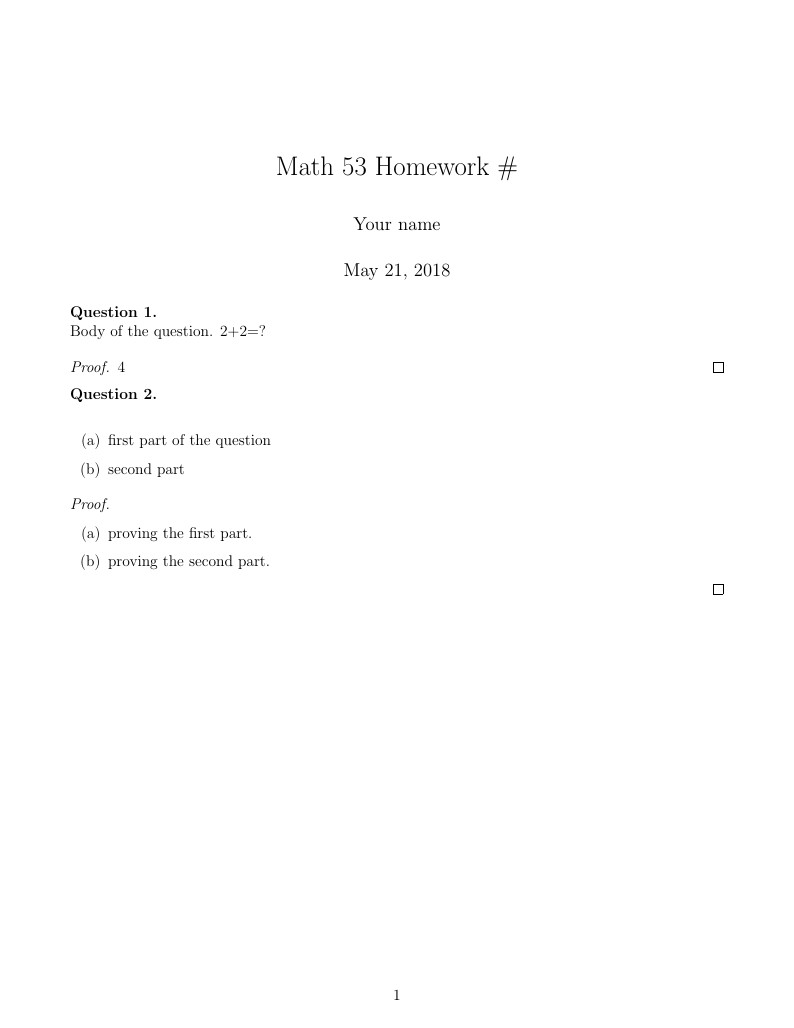
Math 53 Homework template
Forfatter:
Jupiter Zhu
Sidst opdateret:
8 år siden
Licens:
Creative Commons CC BY 4.0
Resumé:
For math 53 homework

\begin
Discover why over 20 million people worldwide trust Overleaf with their work.
For math 53 homework

\begin
Discover why over 20 million people worldwide trust Overleaf with their work.
\documentclass[12pt]{article}
\usepackage{amsmath}
\usepackage{amssymb}
\usepackage{amsthm}
\usepackage{color}
\usepackage{multicol}
\usepackage{enumitem}
%\usepackage{yhmath}
% adjust the margins using the geometry package
\usepackage[left=0.75in, right=0.75in, top=1in, bottom=0.75in]{geometry}
\usepackage[parfill]{parskip}
%\usepackage{mathpazo}
%\usepackage{euler}
\usepackage{mathtools}
% customize the headers using the fancyhdr package
\usepackage{fancyhdr}
\pagestyle{fancy}
\usepackage{hyperref}
\usepackage{mathrsfs}
\renewcommand{\headrulewidth}{0.4pt}
\renewcommand{\footrulewidth}{0.4pt}
% create theorem style
\newtheoremstyle{break}% name
{}% Space above, empty = `usual value'
{}% Space below
{}% Body font
{}% Indent amount (empty = no indent, \parindent = para indent)
{\bfseries}% Thm head font
{.}% Punctuation after thm head
{\newline}% Space after thm head: \newline = linebreak
{}% Thm head spec
\theoremstyle{break}
\newtheorem{hwquestion}{Question}
\newtheorem{theorem}{Theorem}
\numberwithin{theorem}{subsection}
\newtheorem*{lemma*}{Lemma}
\newtheorem{lemma}{Lemma}
\numberwithin{lemma}{subsection}
\newtheorem{corollary}{Corollary}
\numberwithin{corollary}{subsection}
\newtheorem*{definition}{Definition}
\newtheorem*{note*}{Note}
\newtheorem*{remark}{Remark}
\newtheorem*{example}{Example}
\numberwithin{equation}{subsection}
%mathbb short cut
\newcommand{\R}{\mathbb{R}}
\newcommand{\bP}{\mathbb{bP}}
\newcommand{\N}{\mathbb{N}}
\newcommand{\Q}{\mathbb{Q}}
\newcommand{\A}{\mathbb{A}}
\newcommand{\bS}{\mathbb{S}}
\newcommand{\Z}{\mathbb{Z}}
\newcommand{\F}{\mathbb{F}}
\newcommand{\B}{\mathbb{B}}
\newcommand{\T}{\mathbb{T}}
\newcommand{\K}{\mathbb{K}}
\newcommand{\C}{\mathbb{C}}
\newcommand{\D}{\mathbb{D}}
\usepackage{comment}
%bm short cut
\newcommand{\bmv}{\bm{v}}
\newcommand{\bmu}{\bm{u}}
\newcommand{\bmw}{\bm{w}}
\newcommand{\bmx}{\bm{x}}
%mathcal shortcut
\newcommand{\cF}{\mathcal{F}}
\newcommand{\cA}{\mathcal{A}}
\newcommand{\cM}{\mathcal{M}}
\newcommand{\cU}{\mathcal{U}}
\newcommand{\cB}{\mathcal{B}}
\newcommand{\cD}{\mathcal{D}}
\newcommand{\cL}{\mathcal{L}}
\newcommand{\cS}{\mathcal{S}}
\newcommand{\cG}{\mathcal{G}}
\newcommand{\cT}{\mathcal{T}}
\newcommand{\cC}{\mathcal{C}}
\newcommand{\cH}{\mathcal{H}}
\newcommand{\cO}{\mathcal{O}}
\newcommand{\cJ}{\mathcal{J}}
%mathfraktur shortcut
\newcommand{\frp}{\mathfrak{p}}
\newcommand{\frq}{\mathfrak{q}}
\newcommand{\frm}{\mathfrak{m}}
\newcommand{\frP}{\mathfrak{P}}
%mathscr shortcut
\newcommand{\msF}{\mathscr{F}}
\newcommand{\msA}{\mathscr{A}}
\newcommand{\msM}{\mathscr{M}}
\newcommand{\msE}{\mathscr{E}}
\newcommand{\msU}{\mathscr{U}}
\newcommand{\msB}{\mathscr{B}}
\newcommand{\msD}{\mathscr{D}}
\newcommand{\msL}{\mathscr{L}}
\newcommand{\msS}{\mathscr{S}}
\newcommand{\msG}{\mathscr{G}}
\newcommand{\msT}{\mathscr{T}}
\newcommand{\msC}{\mathscr{C}}
\newcommand{\msH}{\mathscr{H}}
\newcommand{\msO}{\mathscr{O}}
\newcommand{\msJ}{\mathscr{J}}
%set notation shortcut
\newcommand{\llangle}{\left\langle}
\newcommand{\rrangle}{\right\rangle}
\newcommand{\llbrace}{\left\lbrace}
\newcommand{\rrbrace}{\right\rbrace}
\newcommand{\setof}[1]{\left\lbrace #1 \right\rbrace}
\newcommand{\cFA}{\cF(\cA)}
\newcommand{\sigmaA}{\sigma(\cA)}
\newcommand{\del}[2]{\frac{\partial #1}{\partial #2}}
\newcommand{\innerproductb}[2]{\llangle\bm{#1},\bm{#2}\rrangle}
\newcommand{\innerproduct}[2]{\llangle{#1},{#2}\rrangle}
\newcommand{\cl}{\operatorname{cl}}
\newcommand{\coker}{\operatorname{coker}}
\newcommand{\re}{\operatorname{Re}}
\newcommand{\im}{\operatorname{Im}}
\newcommand{\dist}{\operatorname{dist}}
\newcommand{\Span}{\operatorname{Span}}
\newcommand{\Supp}{\operatorname{Supp}}
\newcommand{\id}{\operatorname{id}}
\newcommand{\sh}{\operatorname{sh}}
\newcommand{\var}{\operatorname{Var}}
\newcommand{\Proj}{\operatorname{Proj}}
\newcommand{\Ker}{\operatorname{Ker}}
\newcommand{\Mor}{\operatorname{Mor}}
\newcommand{\supp}{\operatorname{supp}}
\newcommand{\Ran}{\operatorname{Ran}}
\newcommand{\Res}{\operatorname{Res}}
\newcommand{\Mod}{\operatorname{Mod}}
\newcommand{\res}{\operatorname{res}}
\newcommand{\Frac}{\operatorname{Frac}}
\newcommand{\End}{\operatorname{End}}
\newcommand{\Sym}{\operatorname{Sym}}
\newcommand{\Spec}{\operatorname{Spec}}
\newcommand*{\sheafhom}{\mathcal{H}\kern -.5pt \it{ om}}
\newcommand*{\sheafspec}{\mathcal{S}\kern -.5pt \it{ pec}}
\newcommand*{\sheafproj}{{\mathcal{P}\kern -.5pt \it{ roj}}}
\newcommand{\Div}{\operatorname{div}}
\newcommand{\Aut}{\operatorname{Aut}}
\newcommand{\Hom}{\operatorname{Hom}}
\newcommand{\Qcoh}{\operatorname{Qcoh}}
\newcommand{\PGL}{\operatorname{PGL}}
\newcommand{\Op}{\operatorname{Op}}
\newcommand{\WF}{\operatorname{WF}}
\newcommand{\Char}{\operatorname{Char}}
\newcommand{\Ell}{\operatorname{Ell}}
\newcommand{\RE}{\operatorname{Re}}
\newcommand{\IM}{\operatorname{Im}}
\title{Math 53 Homework \#}
\author{Your name}
\rhead{Name \& ID: Jdoe 12345 }
\lhead{}
\lfoot{\today}
\cfoot{}
\rfoot{\thepage}
\setlength{\headheight}{15pt}
%%%%%%%%%%%%%%%%%%%%%%%%%%%%%%%%%%%%%%%%%%%%%%%%%%%%%%%%%%%%%%%%%%%%%%%%%%%%%%%%%%%%%%%%%%%%%%%%%%%%%%%%%%%%%%%%%%%%%%%%%%%%%%%%%%%%%%%%%%%%%%%%%%%%%%%%%%%%%%%%%%%%%%%%%%%%%%%%
\setlist[enumerate,1]{label=(\alph*)}
\begin{document}
\maketitle
\begin{hwquestion}
Body of the question. 2+2=?
\end{hwquestion}
\begin{proof}
4
\end{proof}
\begin{hwquestion}
\ %%% break hte line to make the enumerate align better
\begin{enumerate}
\item first part of the question
\item second part
\end{enumerate}
\end{hwquestion}
\begin{proof}
\ %%% break theline to make the enumerate align better
\begin{enumerate}
\item proving the first part.
\item proving the second part.
\end{enumerate}
\end{proof}
\end{document}